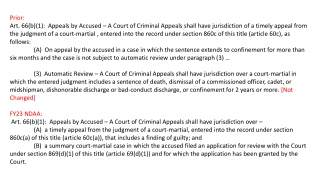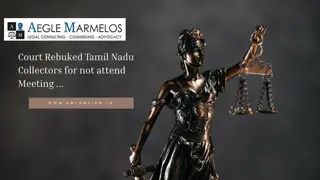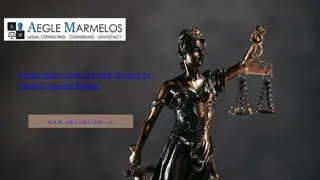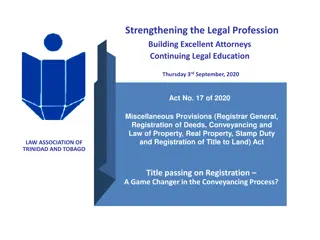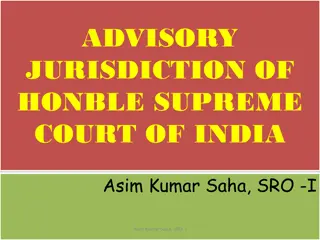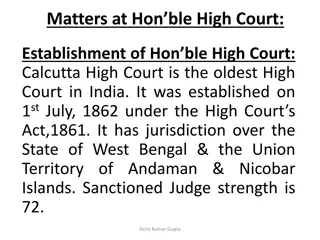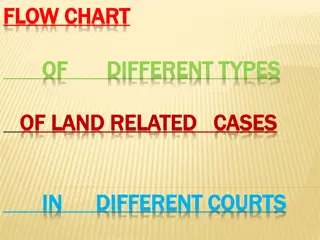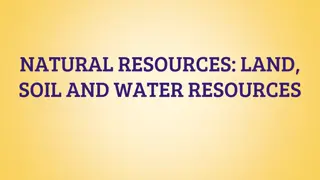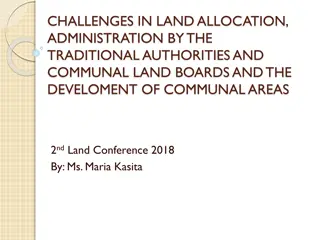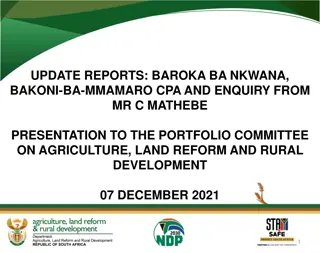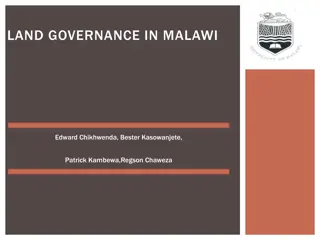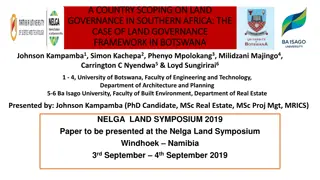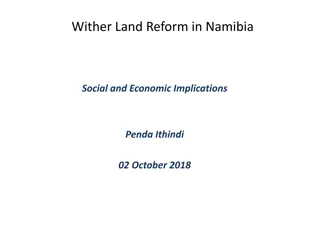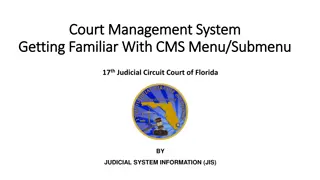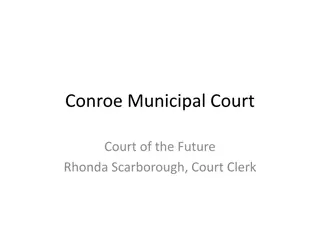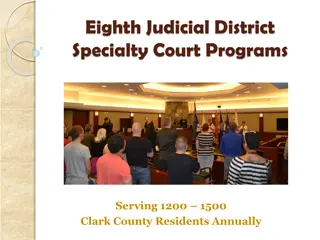Mori Land Court History
The history of the Mori Land Court, known as Te Kooti Whenua, explores the establishment, purpose, and impact of the court on land tenure in Aotearoa (New Zealand). It delves into the conversion of Mori customary land titles, the mana whenua concept, and the process of proving land rights. The court's role in land tenure and alienation is highlighted, along with the cost to the Mori people and the modern-day implications of the court.
Uploaded on Feb 20, 2025 | 0 Views
Download Presentation

Please find below an Image/Link to download the presentation.
The content on the website is provided AS IS for your information and personal use only. It may not be sold, licensed, or shared on other websites without obtaining consent from the author.If you encounter any issues during the download, it is possible that the publisher has removed the file from their server.
You are allowed to download the files provided on this website for personal or commercial use, subject to the condition that they are used lawfully. All files are the property of their respective owners.
The content on the website is provided AS IS for your information and personal use only. It may not be sold, licensed, or shared on other websites without obtaining consent from the author.
E N D
Presentation Transcript
TE KOOTI WHENUA OR TE KOOTI TANGO WHENUA (the land-taking court)
HE KRERO TMATANGA/INTRODUCTION Mana whenua t turu (M ori Customary Land Tenure how M ori defined who owned what according to tikanga) 1. 2. Te mana whenua me te whakawhiti whenua (land tenure and alienation, pre- Native Land Court) Ka t te Kooti Whenua M ori (establishing the Native Land Court why) 3. Te whakam rama i te mana whenua (proving rights to land) 4. Ng mahi a te Kooti Whenua M ori (the court in practice) 5. Ng utu ki te M ori (cost to Maori) 6. Ko Rangitoto-ki-te-tonga me te Kooti Whenua M ori (the Rangitoto experience) 7. Mai i te kupu Native ki te kupu M ori, 1920 1980 (the court from 1920-80) 8. Te Kooti Whenua M ori i ianei (the court today) 9.
1. MANA WHENUA TTURU M ori lived according to a complex system of customary laws. These were based in concepts such as: mana tapu r hui utu muru Some laws attempted to take account of customary practice, but they were never fully implemented.
1. MANA WHENUA TTURU Te Ao M ori ki Te Ao Pakeha belonging to the land versus land belonging to you Rights to occupy and use tribal lands held collectively by all tribal members Rights sustained through continued occupation or use ahi k .
1. MANA WHENUA TTURU A hapu/iwi would base its claim to land upon a take (right) supported by occupation. These take included: take taunaha or take kite take raupatu take tuku take t puna
2. TE MANA WHENUA ME TE WHAKAWHITI WHENUA There are three main types of land ownership in Aotearoa: Crown land belongs to the state General land, which is ordinary private land M ori land is owned by M ori and is subject to the jurisdiction of the M ori Land Court. After the Te Tiriti was signed in 1840, only the Crown could buy M ori land, which was then resold to settlers to fund and promote P keh settlement. From 1863 individuals could buy land directly from M ori.
TAPAETANGA WHENUA MORI: TE WAIPOUNAMU (THE ALIENATION OF LAND IN THE SOUTH ISLAND) 1840 1853 1900
3. KA TTE KOOTI WHENUA MORI The purpose was to: convert M ori customary title to something like English title so the land could be leased but preferably sold M ori could be issued with legal title to their ancestral lands after proving ownership No parallel system in any other country 1862 first court established under M ori judges After 1865, the M ori judges were demoted to position of assessors and no longer had a decisive role in matters of M ori custom.
Justice minister Henry Sewell described the aims of the court as: to bring the great bulk of the lands within the reach of colonisation and the detribalisation of the M ori to destroy, if it were possible, the principle of communism upon which their social system is based and which stands as a barrier in the way of all attempts to amalgamate the M ori race into our social and political system.
4. TE WHAKAMRAMA I TE MANA WHENUA The process involved three separate steps: 1. Title investigation to determine its owners and relative interests 2. Once it had made its decision, the Court would issue a certificate of title to the owners. 3. The owners now had a freehold title. They could sell the block, lease it, try to raise money on it, or simply farm it and live there themselves.
4. TE WHAKAMRAMA I TE MANA WHENUA The court usually heard evidence on four take: ahi k take tupuna take raupatu take tuku Other take sometimes included were Ringa Kaha, and Aroha
4. TE WHAKAMRAMA I TE MANA WHENUA M ori were forced to argue their claims to lands before the courts, and P keh judges tried to interpret M ori custom. Judges often simplified and distorted those customs, and seemed to show a preference for claims based on raupatu (conquest), followed by ahi k .
5. NG MAHI A TE KOOTI WHENUA MORI To simplify M ori land transactions no more than 10 owners ( 10-owner rule) were recorded for blocks of less than 5,000 acres designed to be trustees for the rest of the hapu. In 1873 the 10-owner rule abolished all those with interests in the land became equal owners. Courts judgements were made by a presiding judge and two M ori assessors kept separate minute books
6. NG UTU KI TE MORI MP Robert Bruce declared that: we could not devise a more ingenious method of destroying the whole of the Maori race than by these land courts. The natives come from the villages in the interior, and have to hang about for months in our centres of population ... They are brought into contact with the lowest classes of society, and are exposed to temptation, the result is that a great number contract our diseases and die.
6. NG UTU KI TE MORI The court ignored complex M ori customs relating to land ownership and succession in favour of a simplified set of rules. Te Kooti proved costly on many levels: 1. destabilised M ori society 2. undermined tribal authority 3. court process very expensive for M ori
6. NG UTU KI TE MORI According to M ori custom the group who occupied a block of land held decision-making rights over it. The Native Land Court did not uphold this custom M ori forced to argue claims to lands before the courts P keh judges tried to interpret M ori custom. Judges often simplified and distorted those customs, and often showed a preference for claims based on raupatu (conquest), followed by ahi k . M ori communities set up their own tribal komiti (committees) as an alternative to the Native Land Court. The Crown recognised these only as advisory bodies to the court.
6. NG UTU KI TE MORI The court could only investigate blocks after they had been surveyed, and the survey costs were met by the M ori owners. Often 20% or more of the value of a block was consumed by its survey costs. The claimants then had to attend court sittings where they were prey to a predatory horde of storekeepers, grog-sellers, surveyors, lawyers, land- agents and money-lenders court sittings sometimes lasted for months, resulting in additional court costs and legal fees, as well as travel and accommodation costs for the landowners and competing claimants.
7. KO RANGITOTO-KI-TE-TONGA ME TE KOOTI WHENUA M ORI Rangitoto was exempted from sale to the Crown in 1853 by the Ng ti Toa Also excluded from the lands sold by Ng ti Koata in 1856 In the 1860s and 1870s the southern part of the island was used by Ng ti Koata for market gardening Rest of island leased
7. KO RANGITOTO-KI-TE-TONGA ME TE KOOTI WHENUA M ORI In 1883, Judge Mair awarded the ownership of Rangitoto and the surrounding smaller islands to 79 members of Ngati Koata. The make-up of the ownership list was largely decided out of court by Ngati Koata. Three days of negotiation to get list Court minutes brief much of the business being conducted out of court Ng ti Kuia did not make a counter-claim, so the court awarded the title of Rangitoto and the surrounding smaller islands to Ng ti Koata Title was issued in the Native Land Court at Nelson in 1883
7. KO RANGITOTO-KI-TE-TONGA ME TE KOOTI WHENUA M ORI There were later petitions and applications made on the basis that people had been left out of the list of owners because they were living away from the area at the time of the hearing: E.g. In 1890, K repa Tengi and 12 others petitioned Parliament, asking for an Act to enable them to insert their names into the list of owners, as they had been living at Waitara at the time of the title investigation. Government agreed, but no further action
7. KO RANGITOTO-KI-TE-TONGA ME TE KOOTI WHENUA M ORI In 1895 Renata Te Pau applied to partition Rangitoto and define the shares of the owners Task was complicated as many owners had, since 1883, left for the North Island and their reserves at Croisilles Hearing held in Porirua as many owners lived in the North Island, particularly at Porirua and the Taranaki district.
7. KO RANGITOTO-KI-TE-TONGA ME TE KOOTI WHENUA M ORI Out-of-court arrangements Ng ti Koata r nanga, and a small K miti of prominent rangatira divided Koata into three classes of owners who were allotted land according to: when they arrived on the island their relationship to the original heke their descent from the categories of right holders
7. KO RANGITOTO-KI-TE-TONGA ME TE KOOTI WHENUA M ORI Rangitoto was partitioned into 11 blocks. During the hearing claims were made for the inclusion of more names in the lists of owners, but Judge Mackay was unable to alter the original ownership award. Some people who had been omitted in 1883 were included in the title by allowing existing owners to transfer part of their share to others who had not been included In 1901 six owners successfully petitioned Parliament to have their names included in the title, on the grounds that it had been agreed that one owner held an area of land in trust for them.
7. KO RANGITOTO-KI-TE-TONGA ME TE KOOTI WHENUA M ORI Restrictions were placed over the Rangitoto blocks and outlying islands making them inalienable except by way of lease for up to 21 years but this was soon ignored by the Govt The poor nature of the land on Rangitoto made it unsuitable to sustain the Ngati Koata population, and it was acknowledged that Ngati Koata would not have access to development finance, which meant that the Crown created a position whereby only Pakeha farmers would be able to profitably farm the island.
Block Rangitoto 1 Rangitoto 2 Rangitoto 3 Rangitoto 4 Rangitoto 5 Rangitoto 6 Rangitoto 7 Rangitoto 8 Rangitoto 9 Rangitoto 10 Rangitoto 11 Islands Reserves % in Maori ownership 54% 0.2% 14% 10% 14% 17% 0% 38% 0% 7% 0% 33% 100%
8. MAI I TE KUPU NATIVE KI TE KUPU MORI, 1920 1980 In 1947 the court became the M ori Land Court. From 1953 M ori could be forced to sell land worth less than 25 to the government. The Maori Affairs Act 1953 defined three types of M ori land customary, freehold and reserve land. M ori could be forced to sell land worth less than 25 ($50) to the government by vesting to M ori Trustee. M ori opposition to the compulsory acquisition of uneconomic interests (land blocks worth less than $50) and provision to convert M ori land with fewer than five owners to general land led to the act s replacement by the Maori Affairs Amendment Act 1974.
9. TE KOOTI WHENUA MORI I IANEI From the 1970s M ori issues including land issues became more prominent. After 1993 the M ori Land Court s objectives were to keep M ori land in M ori ownership, and to promote its use and development. In the 2000s all M ori land transactions must go through the court In the 2000s, as the M ori Land Court, it had a very different focus to keep land in M ori hands and to promote its use and development.
HE KRERO WHAKAMUTUNGA New M ori Land Service????


